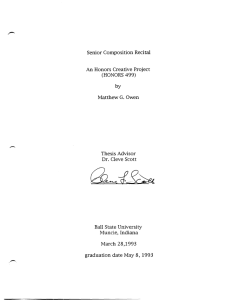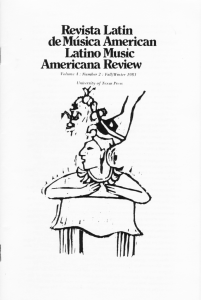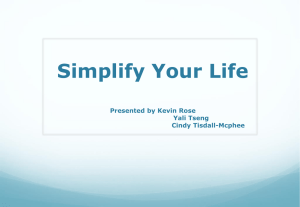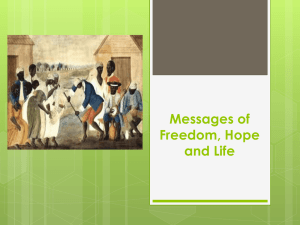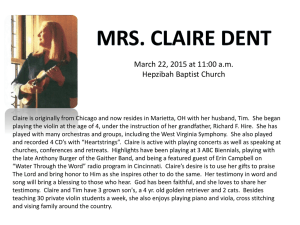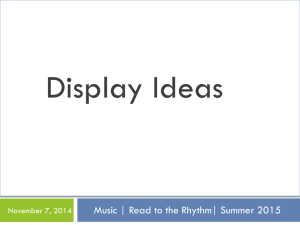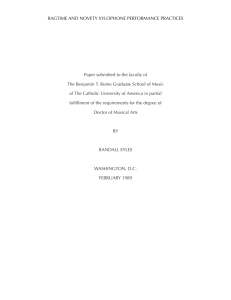Changing lives through marimbas
advertisement
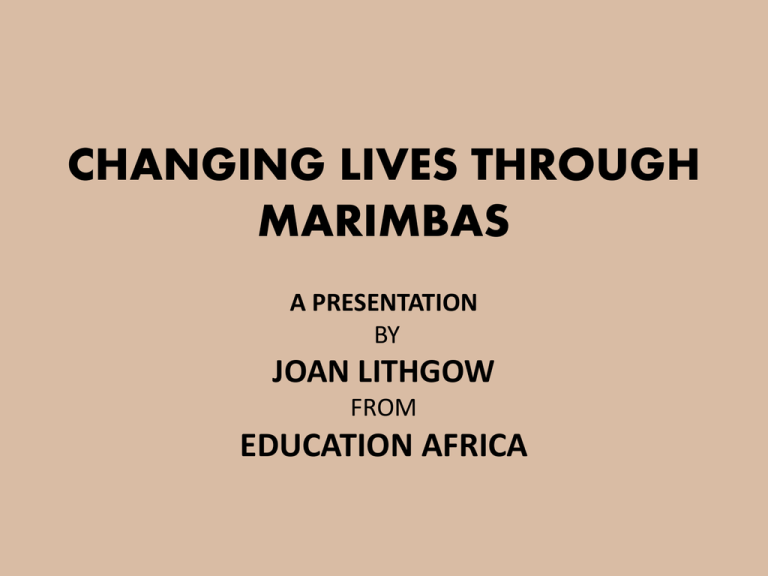
CHANGING LIVES THROUGH MARIMBAS A PRESENTATION BY JOAN LITHGOW FROM EDUCATION AFRICA MUSIC EDUCATION IS AN ELITIST ACTIVITY • By and large music education is an ELITIST activity in most of the world. • Only those people who can afford private lessons, expensive instruments and exam fees can enter this elitist “club” • While I fully acknowledge the incredible work that all private music teachers do, I, personally believe that music lessons should be for everyone and NOT just the few that can afford them. “When I am asked why I teach music the answer is never to create good music, or create musicians! It is always the other “things” that engaging in music-making does for children: team-building, building of self-esteem, creating a feeling of belonging, developing listening skills for life, being empathetic to others, sensitivity, etc etc. If I get good music out as well it is a bonus. The “good music” is a by-product of the process not the main product! INTRODUCTION TO MARIMBAS WHAT IS A MARIMBA? • A musical instrument that has a frame, resonators and tuned wooden bars • Comes in all shapes and sizes • Orchestral marimbas • African marimbas • Marimbas from Guatamala etc etc • Difference between a marimba and a xylophone EXAMPLES OF VARIOUS MARIMBAS PIPE RESONATORS GOURD RESONATORS BOX RESONATORS ORCHESTRAL MARIMBA WHERE DO MARIMBAS COME FROM? • Africa? • Guatamala? • Asia? BRIEF HISTORY OF THE MARIMBA IN SOUTH AFRICA • Through tremendous effort made in the past decade by various marimba manufacturers, individuals, educational institutions and NGOs marimba-playing has become a sought-after activity by youth of all socio-economic backgrounds. • There is only evidence of two communities in South Africa who once played a truly African xylophone/marimba. These are the Venda and the Shangana/Tsonga, both from the far north. There are no recordings of these available and they are completely obsolete. • However, since the 1970s when marimbas were brought down from Zimbabwe to South Africa a growing tradition of marimba playing has developed. • We now have a burgeoning community of marimba players with thousands of children and adults playing on a variety of marimba instruments throughout South Africa. Unfortunately, the communities that most need to be playing marimbas, seldom get the opportunity as there is no money to set up marimba schools. THE REALITY OF OUR EDUCATION SYSTEM IN MOST OF OUR GOVERNMENT SCHOOLS • • • • Distinct lack of extra-mural activities Huge class sizes Unmotivated teachers due to huge class sizes Undisciplined classes: due to class size and therefore lack of personal space • Unqualified teachers with subjects often being taught by teachers who have NO knowledge of the subject whatsoever! • Particularly evident in Creative Arts! EDUCATION AFRICA • Education Africa’s mission statement is quite clear: “Established in 1992, Education Africa strives to reach and uplift the poorest of the poor. We aim to assist disadvantaged South Africans in their quest to obtain a quality, relevant education in order to ensure that they are in a position to become global citizens and a competitive, productive element in the local job market. Education Africa aims for an educated nation, which in turn will lead to a progressive nation that is in a position to sustain economic growth.” • The educational value of marimba-playing cannot be overemphasized enough. Equally important is the fact that the marimba is a musical instrument of African origin that can easily be played by everyone within a short space of time. MY WORK AT EDUCATION AFRICA • • • • Establish marimba hubs Train teachers to teach the marimba Train children Organise the annual Education Africa International Marimba and Steelpan Festival which attracts about 1600 marimba and steelpan players from South Africa and internationally. This is the largest festival of its kind in the world. • International tours with marimba bands from disadvantaged communities. UNIQUE METHODOLOGY TO TEACH LARGE GROUPS TO PLAY THE MARIMBA • • • • • Teach by rote in small bite-size chunks Teach everyone all the parts Dummy keyboards Memory joggers Rhythmic vocabulary ROTE TEACHING • Extremely difficult to read music playing a keyboard that does not have the “black keys” • Complicated and syncopated rhythms are taught all the time which if taught by music reading would take forever to teach! • Listening, memory and concentration skills are honed when teaching by rote. • It follows the good teaching practice of: HEAR DO AND THEN SEE! • AURAL SKILLS are developed ALL the time! WHY TEACH ALL PARTS TO EVERYONE? • Allows every child the opportunity to grow in the music • Gives every child the vision to see where they can go in the piece • You never have to cancel a performance because one band member does not arrive • Memory development • Creates an understanding of the full score and how all the parts fit together DUMMY KEYBOARDS • • • • Allows more children to learn at the same time Keeps every child focused throughout the lesson Excellent as a discipline tool Gives the learners opportunity to use their tactile sense • No one loses when you use dummy keyboards: you hear the part, you play the part • You only teach ONCE! USE OF MEMORY JOGGERS • Graphic representation of the score • Only used to jog the memory • Particularly useful for people who don’t read music • May be used in conjunction with other forms of technology: cell phones/mp3s • Many scores are rhythmically too difficult to read for “instant music” to take place RHYTHMIC VOCABULARY • Assists with memory of the rhythms • As a result of initial good and thorough teaching with rhythmic vocabulary the learning curve escalates after the first piece A TYPICAL CLASSROOM ARRANGEMENT WHY EVERY SOUTH AFRICAN CHILD SHOULD BE PLAYING MARIMBAS • The marimba is a robust, low maintenance, portable instrument that does not need electricity to operate! • No prior knowledge or musical experience is needed. • Teachers/facilitators can be trained within a relatively few hours and learners are able to play a piece of music in their very first lesson. • Players can advance from beginners to fantastic performers within a short space of time. • Concentration skills are greatly enhanced and worked upon when learning to play marimbas. • Self-confidence and self-esteem are greatly boosted as there is a part for every child to play, regardless of ability. • Because of the recommended technique of playing marimbas: hand to hand/ alternating hands—both sides of the brain are being exercised equally. This does not often happen in many other activities. • Playing music together is a team effort! Each and every member of the team is equally important. • Because it is recommended that hands are alternated all the time, crossing of the midline becomes second nature. • Listening skills are greatly enhanced when playing marimbas: players need to play absolutely together to create a piece of music. • Through various games and exercises learners’ aural training skills may be developed. • It is a known fact that maths and music are inter-related. Marimba music is strongly based on patterning: maths is also full of patterning. It goes without saying that the one helps and reinforces the other. • The science of sound production can be demonstrated and studied through the marimba. • Through singing and spelling games on the marimba, language skills and spelling is improved. • The bars on the marimba are fairly wide so learners with poor fine-motor coordination are still able to play with ease. • Physically and mentally challenged individuals can play marimbas and be part of a marimba band. • Fine- and gross-motor coordination are constantly being worked on when the learners are playing marimbas. • Learners who do not have dexterity in their fingers for whatever reason often find it difficult, if not impossible, to play a melodic musical instrument. The marimba offers these learners the opportunity to play a melodic instrument. • The nature of the music for marimbas is such that there are very easy parts and then there are parts that are graded according to abilities. • By using dummy keyboards in the classroom every learner is focused on playing at the same time. This alleviates discipline problems. • All genres of music can be played on marimbas. • With imagination, patience and a sense of fun the music classroom is transformed into a magical soundscape. • The instruments sell themselves in the classroom and EVERYONE wants to play! ASSESSMENT ASSESSMENT OF A MARIMBA PIECE RUBRIK 1 2 3 4 5 6 Has very little concept of the rhythm and the notes of the part Has very little concept of the rhythm and the notes of the part Weak rhythmic sense with less than half of the notes well known Weak rhythmic sense with less than half of the notes well known Fair rhythmic sense with more than half of the notes well known Mostly steady rhythm with a few incorrect notes Steady rhythm with notes mostly correct Excellent rhythm, correct notes Fair rhythmic sense with more than half of the notes well known Mostly steady rhythm with a few incorrect notes Steady rhythm with notes mostly correct Excellent rhythm, correct notes MELODY Has very little concept of the rhythm and the notes of the part Weak rhythmic sense with less than half of the notes well known Fair rhythmic sense with more than half of the notes well known Mostly steady rhythm with a few incorrect notes Steady rhythm with notes mostly correct Excellent rhythm, correct notes ENSEMBLE Is not able to play an independent part with others Is able to keep an independent part going for a only a bar or two Is able to play an independent part with others for at least half the piece Is able to play an independent part for more than half the piece Is able to play an independent part with others with very little rhythmic inaccuracy Sensitive to other players, keeps playing no matter what! TECHNIQUE None of the five rules adhered to 1 of the 5 rules adhered to 2 of the 5 rules adhered to 3 of the 5 rules adhered to 4 of the 5 rules adhered to All 5 rules adhered to. BASS PART 2ND PART TECHNIQUE RULES • • • • • BOUNCING STICKS ALTERNATING HANDS NO INDEX FINGER ON THE BEATERS PLAYING IN THE MIDDLE OF THE BARS NO “BANGING” THE IMPORTANCE OF THE EDUCATION AFRICA INTERNATIONAL MARIMBA AND STEELPAN FESTIVAL • • • • • INCLUSIVITY SOCIAL COHESION SOCIAL CHANGE NETWORKING OPPORTUNITIES INTERNATIONAL MARIMBA AND STEELPAN FESTIVAL 2014 • DATES: 2nd AND 3rd AUGUST 2014 • VENUE: ST BENEDICT’S COLLEGE HARCUS ROAD BEDFORDVIEW GAUTENG • Email: joan@educationafrica.org • WEBSITE: www.internationalmarimbafestival.org
